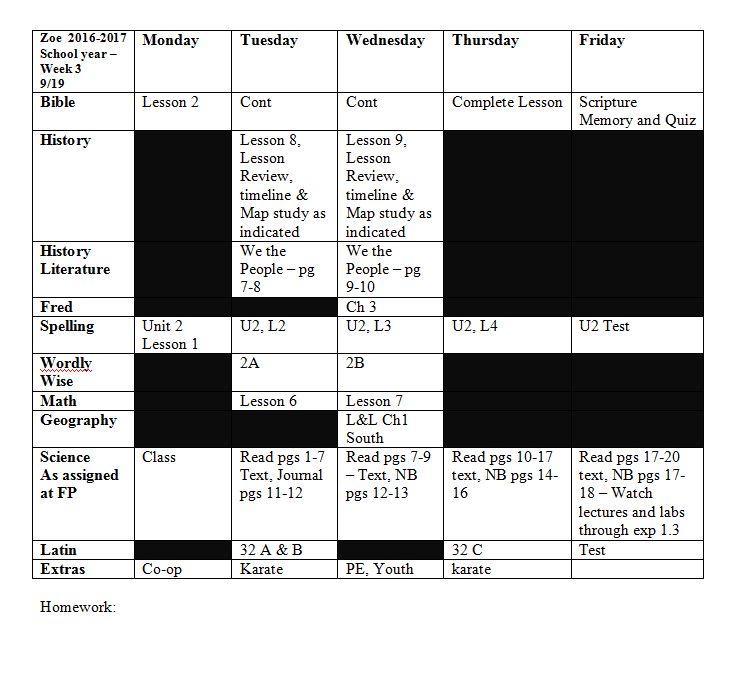
Getting organized and staying organized often make the difference in the level of success of something. This can be applied to so many things in life. To help us be better homeschooling parents - getting organized in your homelife and chores as well as homeschool planning makes for a smoother year.
Over the years, I have come up with some systems that have worked for us. These likely are not for everyone - but maybe you can glean something from them.
Laundry - One day I was at my end. I could not keep up on the laundry in our home for all seven of us. Our youngest child was eight years old, our oldest was 12. I was sharing this with a dear friend of mine, and she mentioned a book that she was reading. (I cannot remember the name of it - but will try to find out and post it here.) She told me how it was about letting go of things that your kids are capable of doing - completely my kind of thing. As a result, I decided that my kids were old enough to do their own laundry. We have five kids and each of them has an assigned day of the week. My husband and I get the weekend. If they miss their day - they wait until the following week - unless a sibling does not need the machines all day. This has helped me a ton.
Menu Planning - I menu plan every four months. Some people think it is crazy or super ambitious or way too overwhelming. I didn't start with planning four months at a time. I started with a month at a time. This has grown into four months - which works well with the seasons. (We like to change what we eat a bit, depending on the time of year.) Also - I only meal plan for dinners. I have a different solution for breakfast and lunch - I will share that below. If you are wanting to give this a shot - I recommend starting with just a month at a time and grow from there.
The process is really very simple. Take a monthly calendar - I just print mine from my google calendar - it already has our family activities listed - so I can plan meals around what we have going on. Grab your favorite cook books, recipes you have printed from FaceBook, etc, grab a cup of tea or coffee and get comfortable - the first time does take a bit of time. Then write in each day a meal - make a small reference note as to where you can find the recipe - book/pg number. Repeat meals as often as you like - we typically only have a repeat meal once or twice in a month. If you are having trouble coming up with enough meals, as your kids what they like. Don't forget things like Leftover Night, Breakfast for Dinner, Taco Night, Soup and salad bar, Chili and baked potatoes. These are some fast and easy things to fill some of the spaces. If your plans change or you end up making something different - that is ok - the plan can always change - just have a plan. This helps keep the grocery bill down - because you are buying spefics - not just what looks good as you walk through the store.
Once you have two or three months worth done, over time, just take those old menus plans and recycle them - replacing a meal or two a week with something new or different. Once you have this down - meal planning every four months can be done in under an hour.
As for breakfast and lunch - I have a lamenated sheet of paper with the M-F breakfast options and lunch options for my kids. Since they are old enough to do things on their own - I let them. Breakfast - Monday is cereal and yogurt or fruit, Tues is eggs and fruit, Wed is oatmeal and yogurt, Thur is frozen breakfast and Fri is Mom made. Lunch - Monday is soup/sandwich, Tues is burritos or chicken melt sandwiches, Wed is fish or chicken with crackers/fruit, Thurs is frozen pizza, Fri is leftover or pack a lunch for an outing. The breakfast and lunch meals stay the same each week - so it is easier to make grocery lists, manage a grocery budget and buy in bulk to help keep grocery bills down.
To help keep grocery bills down - I use several different apps, Grocery Hog, Checkout 51, Walmart, ibotta, Saving Star. I save an average of $10-15 a week by using these. At $10 a week - that is over $500 a year. Certainly worth the few min of time for me.
**Update - Now that I have five - yes five teenagers, we do something a little different with meal planning - Each member of the family has a set night of the week that we cook. I know that every week I cook for the family on Monday nights. I plan around that. Everyone gets me their ingredient needs by Wednesday the week before and we are set for the next week. They do not get to do box meals - everything is prepared by them - this has been a lifesaver as I have started working again.
Lesson Planning - So over the years, I tried a few different things. My first year homeschooling, I thought I had to have lesson plans all laid out and specific. Then I realized that all we were doing is turning the page and doing the next lesson every day. I stopped stressing out over that. When the kids got a little older and not everyone was doing the same thing, I started doing lesson plans every Sunday for the following week. This didn't go very well either. Sunday night would come and I would be tired and dreading the planning process - knowing that I had to get it done before going to bed. Then I got ambitious. I decided I would lesson plan for th entire year for each child. At first it took me about 8-10 hours for each child. Now it takes me about five hours of solid work for each child - but I can get it done and I don't have to think about it again for the entire year. So how does one go about doing this - it is much easier than it sounds. The steps are below.
- First, look at the school year coming up. Are there days that you know you will out of town or wanting to take off - holidays, birthdays, spring break, etc.
- Next, decide how many days a week you want to do school - are you in a co-op that will reduce the number of days you school at home. Do you want to have a four day school week and keep it flexible for field trips or just have a "catch up" day.
- Lastly, decide your start and end dates. Typically most curriculum is complete within 36 weeks - sometimes less. You can always add on a week or two for cushion if you want.
- I like to use Word for this project. I make a table in Word with six columns - you might have less if you have a shorter school week. You can see from the sample below that we had a busy week pre-scheduled and I knew we wouldn't be doing alot of school certain days.
- Generally speaking - all curriculum is divided into a set number of lessons for your, or they have a few different suggested plans for you to use. I take it one subject at a time. I would open the history book, for example, see how many lessons there are - in this case, it was 150. If we usually do 4 lessons a week, we should get done in 36 weeks. Now truth be told, we typically double up in the last few weeks of school - because we are eager to start our summer. Wordly Wise has 20 units with five lessons and a test every week. There are also mid term tests, final tests and crossword puzzles. We opted to skip the crosswords, but I did need to keep the tests in mind when scheduling things out. Don't forget that. The fewer the number of lessons, the fewer times a week the child needs to do that subject.
- What happens if someone is sick or we take an unexpected vacation? If someone is sick in our house - they catch up as they are able. If we take an unexpected vacation - we shift the schedule by a week or double up down the road until we are caught up. Little hiccups will come up - but for me - having this completed with the exception of a small margin of unexpected change - is far less stressful than how I was doing it.
- Lastly, I make one full copy for myself and one for the child. Their copy goes in a 3 ring binder. The child can look ahead and see what projects and things are coming up - it helps for them to have this information so they can start to really own their school work and schedule. My copy also goes in a 3 ring binder, but I have dividers for each child to keep the plans seperate. The copy that I keep is where I keep track of their grades for the week. For example - Monday of every week, I go to my binder, pull out the week's lesson plan for each child. I put them on a clip board. As my kids finish their days assignments and place them in my inbox, I grade them. They either have to make corrections or not - I put the assignment in the out box. Once I have graded the assignment, I note on my copy of the lesson plan what their grade was and enter the information into my excel spreadsheet at the end of the week after averaging the week's scores. This way I never have stacks of grading that I procrastinate completing.
Are you looking for some curriculum to fill in the gaps or add some fun and interest to the week? Check out the Homeschool Resources Bundle Salesale - here for a limited time.

